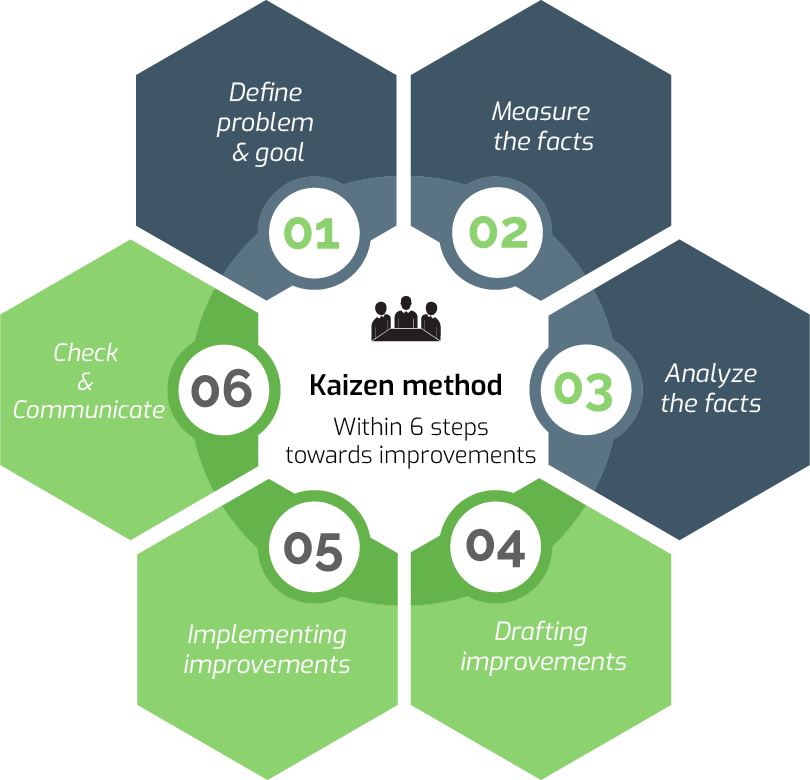Every production environment is essentially an improvement environment. After all, continuous efforts are made to enhance the speed, precision and safety of the production line. To discover potential improvements in the production line and implement them into an improvement plan, there are several methods you can employ. The Kaizen method is one of the classic methods utilized in production environments.
What is the Kaizen method?
The mission of the Kaizen method is embedded in its own name. Kaizen consists of two Japanese words: ‘kai’ and ‘zen’, which mean ‘change’ and ‘good,’ respectively. Therefore, the Japanese Kaizen method is focused on implementing as many improvements as possible, aiming to make it a daily activity within the organization. The art of Kaizen involves humanizing the workplace for employees by eliminating work that is mentally and physically demanding and coming up with solutions to support or replace this work. By integrating the Kaizen method into daily work methodology, everyone involved in production learns to recognize and eliminate waste in the production process. Thus, the Japanese Kaizen method focuses on the long-term strategy of an organization.
Implementing the Kaizen method: Small steps make big improvements
The Kaizen method is divided into small steps, allowing for easy application—even for more complex issues. Due to these small steps, the method is also known as the ‘small steps method’. All these small steps together result in a significant improvement that guarantees enhancement. Good Kaizen examples include optimizing inventory control and standardizing production. However, Kaizen can also involve the cycle an organization follows for continuous improvement or the elimination of waste (such as materials, profits or time). By delving into one specific improvement point each time, an organization checks the efficiency of a production component from start to finish. It is like looking at it for the first time, yielding many new valuable insights as a result.
The 6 steps in a row
Even though Kaizen is designed for continuous improvement, Kaizen events focusing on a single problem will naturally occur regularly. When you do this, you can follow the 6 steps of Kaizen that we describe below.

Step 1: Define the problem and the objective
Without a problem or waste, there can be no potential improvement. Therefore, select a specific problem you want to analyse closely and link a realistic objective to this problem, enabling you to determine afterward if the Kaizen event was successful or not. Formulate both the problem and the objective as clearly as possible.
Step 2: Gather the facts
Analysing a problem can only be done if you have experienced the problem up close. So, head to the work floor and observe the problem firsthand to collect relevant data. Gather the facts!
Step 3: Analyse the facts
Once you have collected the facts (data), delve into them thoroughly. Brainstorm with other employees about possible causes, perhaps using a fishbone diagram. Then, select the major causes of the problem.
Step 4: Determine improvements
Continue brainstorming, this time focusing on suitable improvements related to the causes of the problem. Collaboratively determine improvements that can be effectively implemented within the specified timeframe.
Step 5: Implement the improvements
Organize the improvements and integrate them within the organization. It can be helpful to create an implementation plan detailing who is responsible for implementing the plan, how the implementation should take place and what deadline will be set.
Step 6: Check and communicate
Once the improvements have been implemented, it’s time to conduct regular checks. Is the problem permanently resolved? And how does the devised solution perform? Communicate the findings with the team and make them aware of the new approach associated with the implemented improvement.
How to implement the Kaizen method for your organization?
Want to master the art of Kaizen as well? It all starts with standardizing the tasks that employees need to perform to keep production running. By providing clear, visual work instructions for every production step via an online platform and having everyone follow them, peculiarities and areas for improvement are discovered more rapidly. Utilizing an online platform like EZ-GO makes this visible, allowing everyone to follow the necessary steps and immediately report any deviations in the process. Thus, you precisely know the status of the production line and when action needs to be taken. This is especially beneficial when audits are approaching!


